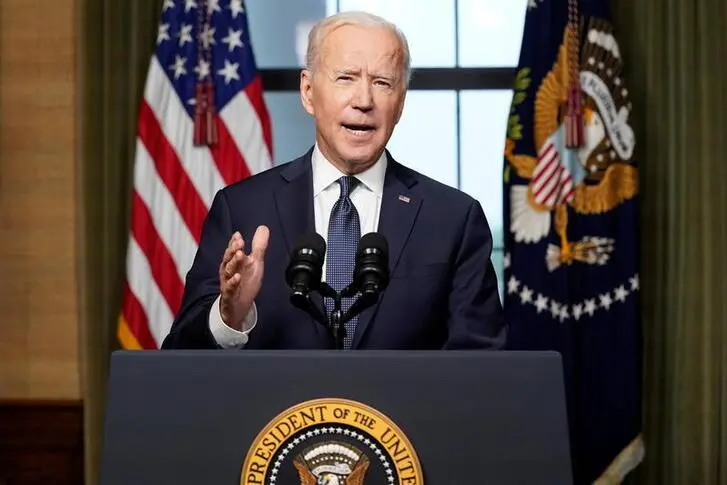PHOTO
(The opinions expressed here are those of the author, a columnist for Reuters.)
LONDON- With warship moves, equipment sales and diplomatic rhetoric, the United States has rarely been more emphatic that it stands with its allies in Ukraine and Taiwan.
For all those declarations, however what that truly means remains unclear.
Both Moscow and Beijing appear intent on testing the Biden administration, still less than three months old. Russia has mobilised more troops on Ukraine’s border than at any point since its 2014 war, while China has sent an aircraft carrier, drones and a “citizen militia” of fishing boats to territories also claimed by U.S. allies like the Philippines.
Such activity is in part grand strategic ballet, posturing that no side wants to escalate to outright war. But as the last two weeks have shown, as matters approach crisis point they can escalate at speed – forcing tougher choices on the United States.
To quote U.S. Secretary of State Antony Blinken, Washington believes it would be a “serious mistake” for China to move on Taiwan and has “serious concerns” over Russia’s military manoeuvres near Ukraine.
Following a meeting with Ukraine’s Foreign Minister Dmytro Kuleba on Tuesday in Brussels, the language was even blunter: “The United States stands firmly behind the sovereignty and territorial integrity of Ukraine,” Blinken said. NATO Secretary General Jens Stoltenberg went further, saying the alliance had “unwavering” support for Ukraine.
NO ARTICLE 5
What that really means, however, is never articulated. Ukraine is not a member of NATO, and therefore lacks the binding guarantees of “Article 5” support from allies if attacked. Similarly, the 1979 U.S. Taiwan Relations Act deliberately maintains an air of “strategic ambiguity” over whether America would intervene in any conflict.
From Moscow and Beijing, the military posturing is unambiguous – even with the ultimate intent less clear. Last week, China sent an aircraft carrier battle group close to Taiwan, a move that has followed months of escalation including dozens of planes testing its airspace. Moscow has mobilised thousands of troops on Ukraine’s border – while accusing Kiev of planning an offensive itself to regain parts of its territory held since 2014 by pro-Russian separatists.
So far, much of the U.S. response to these steps comes in kind: sending a carrier to the South China Sea and U.S. transport aircraft bringing military supplies to Taiwan and Ukraine.
It was also widely reported to include the transit of U.S. destroyers into the Black Sea – but Turkish diplomatic sources said on Wednesday this has been cancelled. U.S. officials told Reuters the movement had never been confirmed in the first place, and Turkey had misunderstood messaging. But the move may inevitably be interpreted as a U.S. climb-down.
U.S. military activity in Asia and Europe was already heightened this year, including NATO’s “Defender 2021” exercise this summer, billed as the largest of its kind since the Cold War.
Such exercises are designed to deter Moscow and Beijing, reminding them that the United States projects global power in ways they could never dream of. But both also now use these drills as a pretext for their own military activity. Russian Defence Minister Sergei Shoigu explicitly linked Russia’s current mass-mobilisation drills to NATO’s “Defender”, saying the scale of U.S.-led military activity required response.
OTHER GAMES
Simultaneously, however, there are other games in play.
Even as Russia rattles sabres at Ukraine, it is lobbying Paris and Berlin to ensure completion of the Nord Stream 2 gas pipeline to Europe. The United States is keen to have that stopped, even appointing a specific envoy tasked to block it. Russia is also hoping to get its Sputnik V vaccine manufactured by European states – and keeping those options open may be a reason to hold back from war.
That doesn’t mean tensions will go away – indeed, they are likely to come and go through this year and beyond. For Russia, turning up the threat level doesn’t just intimidate Ukraine, it distracts Russia’s domestic population from issues such as a new crackdown on supporters of opposition leader Alexei Navalny, now in hospital. It also won Putin a call with Biden and the offer of a summit, a move Moscow has painted as a diplomatic victory.
While Moscow expected relations with Washington to worsen under Biden, China had some hopes they might improve. But President Xi Jinping faces his own domestic challenges – including a fight with Communist Party powerbrokers for a third term. Capturing Taiwan – or whipping up a crisis – might support that effort. In March, the commander of U.S. Pacific Command, Admiral Philip Davidson, said his base case scenario was that assault might come within six years – but it could happen any time.
Whether Russia and China can arrange future crises to happen simultaneously is unclear – but both clearly see common ground against the United States, and have moved closer diplomatically in the last year.
For years, Washington has wondered what it would do if it faced a war with Russia or China, limited or otherwise. Now it must consider the possibility could face both at once.
Peter Apps
*** Peter Apps is a writer on international affairs, globalisation, conflict and other issues. He is the founder and executive director of the Project for Study of the 21st Century; PS21, a non-national, non-partisan, non-ideological think tank. Paralysed by a war-zone car crash in 2006, he also blogs about his disability and other topics. He was previously a reporter for Reuters and continues to be paid by Thomson Reuters. Since 2016, he has been a member of the British Army Reserve and the UK Labour Party.
(Editing by Giles Elgood)












